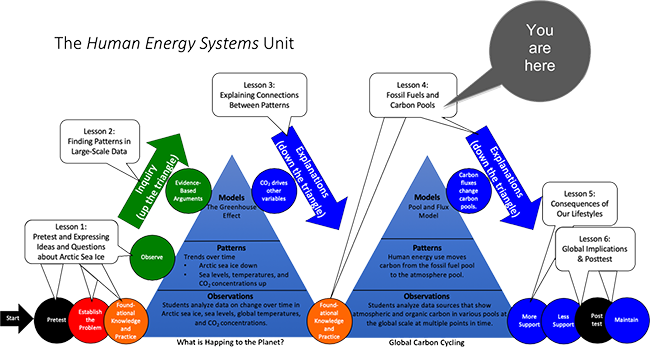Transformations in Matter and Energy Carbon TIME is an NSF-funded partnership led by Michigan State University
Human Energy Systems | Lesson 4 - Fossil Fuels and Carbon Pools
 Overview
Overview
Students are introduced the Four Questions at a large scale to examine the major pools of carbon (with special attention to the fossil fuel pool). Then they look more closely at the Keeling Curve and examine how fossil fuels are formed and how we use them.
Guiding Question
What causes and how can we predict changes in CO2 concentrations?
Activities in this Lesson
- Activity 4.1: Questions for this Lesson (30 min)
- Activity 4.2: Carbon Pools and Fossil Fuels (35 min)
- Activity 4.3: Tiny World Modeling (50 min)
- Activity 4.4: Global Computer Model (50 min)
- Optional Activity 4.5: Effects of Seasons and Oceans (50 min)
Unit Map

Target Student Performance
|
Activity |
Target Performance |
|
|
|
|---|---|
|
Activity 4.1: Questions for this Lesson (30 min) |
Students apply the large-scale Four Questions to two patterns in the Keeling curve (showing atmospheric CO2 concentrations): the annual cycle and the long-term trend. |
|
Activity 4.2: Carbon Pools and Fossil Fuels (35 min) |
Students identify carbon pools in Earth systems and investigate the fluxes associated with human use of one pool: fossil fuels. |
|
Activity 4.3: Tiny World Modeling (50 min) |
Students investigate the relationship between pools and fluxes in a physical model of a tiny world, showing how changing photosynthesis, cellular respiration, and combustion fluxes can account for both an annual cycle and a long-term trend in the atmospheric CO2 pool. |
|
Activity 4.4: Global Computer Model (50 min) |
Students use an online computer model to make quantitative predictions of how changes in photosynthesis, cellular respiration, and combustion fluxes will affect the long-term trend in the atmospheric CO2 pool. |
|
Optional Activity 4.5: Effects of Seasons and Oceans (50 min) |
Students use a diagrammatic carbon cycle model to investigate how oceans and seasons in the Northern and Southern Hemispheres affect the annual cycle and a long-term trend in the atmospheric CO2 pool |
NGSS Performance Expectations
High School
- Ecosystems: Interactions, Energy, and Dynamics. HS-LS2-5. Develop a model to illustrate the role of photosynthesis and cellular respiration in the cycling of carbon among the biosphere, atmosphere, hydrosphere, and geosphere.
- Earth’s Systems. HS-ESS2-2. Analyze geoscience data to make the claim that one change to Earth’s surface can create feedbacks that cause changes to other Earth systems.
- Weather and Climate. HS-ESS2-4. Use a model to describe how variations in the flow of energy into and out of Earth’s systems result in changes in climate.
- Earth and Human Activity. HS-ESS3-5. Analyze geoscience data and the results from global climate models to make an evidence-based forecast of the current rate of global or regional climate change and associated future impacts to Earth systems.
- Earth and Human Activity. HS-ESS3-6. Use a computational representation to illustrate the relationships among Earth systems and how those relationships are being modified due to human activity.
Middle School
- Waves and Electronic Radiation. MS-PS4-2. Develop and use a model to describe that waves are reflected, absorbed, or transmitted through various materials.
- MS-ESS2-1. Develop a model to describe the cycling of the Earth’s materials and the flow of energy that drives this process.
- Human Impacts. MS-ESS3-4. Construct an argument supported by evidence for how increases in human population and per-capital consumption of natural resources impact Earth's systems.
- Earth and Human Activity. MS-ESS3-5. Ask questions to clarify evidence of the factors that have caused the rise in global temperatures over the past century.

 Download PDF of Lesson 4 Teacher's Guide
Download PDF of Lesson 4 Teacher's Guide